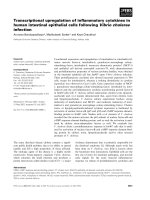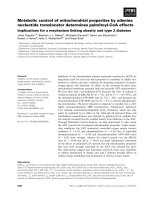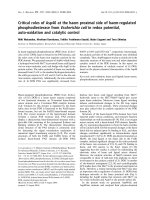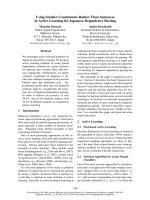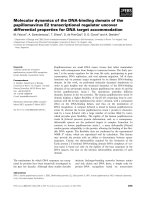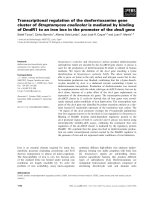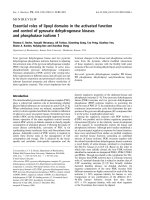báo cáo khoa học: " Transcriptional control of anthocyanin biosynthetic genes in extreme phenotypes for berry pigmentation of naturally occurring grapevines" pptx
Bạn đang xem bản rút gọn của tài liệu. Xem và tải ngay bản đầy đủ của tài liệu tại đây (519.56 KB, 10 trang )
BioMed Central
Page 1 of 10
(page number not for citation purposes)
BMC Plant Biology
Open Access
Research article
Transcriptional control of anthocyanin biosynthetic genes in
extreme phenotypes for berry pigmentation of naturally occurring
grapevines
Simone D Castellarin
1,2
and Gabriele Di Gaspero*
1,2
Address:
1
Istituto di Genomica Applicata, Parco Scientifico e Tecnologico Luigi Danieli, via Jacopo Linussio 51, 33100 Udine, Italy and
2
Dipartimento di Scienze Agrarie e Ambientali, University of Udine, via delle Scienze 208, 33100 Udine, Italy
Email: Simone D Castellarin - ; Gabriele Di Gaspero* -
* Corresponding author
Abstract
Background: Fruit coloration of red-skinned grapevines is mainly due to anthocyanin pigments.
We analysed a panel of nine cultivars that included extreme phenotypes for berry colour, ranging
from green (absence of anthocyanins) to red, purple, violet and blue. Expression of six genes of the
anthocyanin pathway coding for flavanone-hydroxylase (F3H), flavonoid 3'-hydroxylase (F3'H),
flavonoid 3',5'-hydroxylase (F3'5'H), UDP-glucose:flavonoid-3-O-glucosyltransferase (UFGT),
glutathione-S-transferase (GST), O-methyltransferase (OMT) and four transcription factors (MybA,
MybB, MybC, MybD) was analysed by quantitative RT-PCR at four developmental stages from before
the onset of ripening until full maturity and compared to anthocyanin metabolites.
Results: Total anthocyanin content at full maturity correlated well with the cumulative expression
of F3H, UFGT and GST throughout ripening. Transcripts of the last two genes were absent in the
green-skinned cultivar 'Sauvignonasse', also known as 'Tocai friulano', and were at least 10-fold less
abundant in pale red cultivars, such as 'Pinot gris' and 'Gewürztraminer', compared to fully coloured
cultivars. Predominance of tri-hydroxylated anthocyanins (delphinidin, petunidin and malvidin) in
cultivars bearing dark berries with violet and blue hue was associated with higher ratios of F3'5'H/
F3'H transcription, compared to red-skinned cultivars. Higher levels of OMT transcripts were
observed in berries of cultivars that accumulated methoxylated forms of anthocyanins more
abundantly than non-methoxylated forms.
Conclusion: Colour variation of the grape berry conforms to a peculiar pattern of genotype-
specific expression of the whole set of anthocyanin genes in a direct transcript-metabolite-
phenotype relationship. Cumulative mRNA levels of the structural genes and their relative
abundance throughout ripening explained per se the final phenotype for anthocyanin content,
anthocyanin composition, colour intensity and colour hue of grapes at berry maturity.
Background
Regulation of anthocyanin biosynthesis has been studied
across a number of flowering plants thanks to the availa-
bility of colour mutants that have facilitated the dissection
of complex regulatory networks. Many studies have con-
cerned themselves with the genetic control of colour phe-
Published: 30 August 2007
BMC Plant Biology 2007, 7:46 doi:10.1186/1471-2229-7-46
Received: 30 March 2007
Accepted: 30 August 2007
This article is available from: />© 2007 Castellarin and Di Gaspero; licensee BioMed Central Ltd.
This is an Open Access article distributed under the terms of the Creative Commons Attribution License ( />),
which permits unrestricted use, distribution, and reproduction in any medium, provided the original work is properly cited.
BMC Plant Biology 2007, 7:46 />Page 2 of 10
(page number not for citation purposes)
notypes in floral organs of ornamentals (mainly
Antirrhinum majus and Petunia × hybrida) or in kernels of
Zea mays and seed teguments of Arabidopsis thaliana,
which has led to a comprehensive view of the common
features and the species-specific peculiarity of anthocy-
anin regulation in those plants [1-6]. In fruit trees, the
genetics underlying the presence or absence of anthocy-
anin pigmentation has been elucidated in bilberry [7],
grapevine [8,9] and apple [10]. However, studies pertain-
ing to the quantitative and qualitative variation of
anthocyanins in fruit and the resulting shifts in colour
have only scratched the surface of the regulatory network
by separately analysing the role of single genes [11-13] or
single transcription factors [14,15].
Grapevine is a fruit crop that encompasses a wide pheno-
typic variation in berry colour. Plant adaptation to differ-
ent environments and centuries of human selection have
produced numerous genotypes in which the intensity and
the hue of red coloration vary extensively. A mixture of
variations in anthocyanin content and in the relative pro-
portion of different anthocyanins can produce extreme
phenotypes for skin pigmentation. Anthocyanin concen-
tration in epidermal cells correlates well with the darkness
of berry colour. According to [16], anthocyanin concen-
tration ranged from 6.2 to 26 mg kg
-1
of berry in a panel
of 64 pigmented cultivars. Anthocyanin profile and hue
might vary dramatically as well. We have previously dem-
onstrated that the ratio of blue tri-hydroxylated to red di-
hydrohylated anthocyanins is under transcriptional con-
trol of flavonoid 3'(5')-hydroxylase genes (F3'H and
F3'5'H) and it correlates well with the evolution of colour
hue throughout ripening in the cultivar 'Merlot' [11]. All
red cultivars investigated so far synthesise all five grape-
vine anthocyanins (cyanidin, peonidin, delphinidin,
petunidin and malvidin) [16,17]. This means that all cul-
tivars express functional F3'H and F3'5'H genes for the
synthesis of 3'4'-OH and 3'4'5'-OH anthocyanins as well
as O-methyltransferases (OMT) for the methylation of pri-
mary anthocyanins. These genes, alongside other key
genes of the core pathway, are assumed to be differentially
regulated in different genetic backgrounds. The biological
questions we aimed to address are: does most regulation
of the anthocyanin biosynthesis in ripening fruit occur at
transcriptional level in a similar way as it occurs in other
species in pigmented organs other than fruit ? Are the dis-
tinct patterns of expression of structural genes sufficient to
explain the observed variation of contrasting colour phe-
notypes peculiar to each cultivar ?
Red-to-blue colour variation across grapevine cultivars
has evolutionary, technological and health implications
of fascinating interest. It is generally assumed that red col-
oration was the most primitive form of reproductive
organs in plants that synthesise anthocyanins. Anthocy-
anins appeared approximately 120 million years ago
[18,19] and naturally served for the recruitment of seed
dispersers and in UV protection. Unlike roses and carna-
tions, which still do not naturally display blue coloura-
tion, most species including grapevine have later acquired
the capability of synthesising anthocyainic blue pigments.
According to this view, the gene F3'H coding for the
enzyme that leads to red anthocyanins is ancestral to the
gene F3'5'H coding for the enzyme that converts red into
blue anthocyanins [20]. Based on phylogenetic analysis,
most F3'5'H arose from F3'H by gene duplication before
the divergence of angiosperms and gymnosperms but in
the documented case of the Asteraceae family this event
occurred repeatedly and much more recently in the evolu-
tionary time scale [20]. This raises the questions of how
and when genes for blue coloration appeared in the grape
genome. F3'H and F3'5'H currently known in the grape
genome split in two different branches of a phylogenetic
tree, that included also F3'H and F3'5'H from other plants
[11]. F3'5'H from the grape genome grouped together
with the homologous F3'5'H from other species rather
than with the paralogous F3'H from grape. This feature is
predictive of an ancient origin of the F3'5'H found in the
present-day grapevines which was already present in the
palaeo-ancestor before the split of major dicot lineages.
More recently, F3'5'H has undergone further evolution in
the grape genome, as witnessed by the structural complex-
ity of the genomic region on the linkage group 6 contain-
ing F3'5'H [11].
Anthocyanin composition has a technological impact on
the colour of must obtained from a given cultivar. Colour
of pure anthocyanins shifts progressively from red to blue
as the number of substituted groups on the B-ring
increases and as methoxyl groups replace hydroxyl groups
[21]. After must fermentation, anthocyanin stability in
wines is threatened by a number of factors (light exposure,
fluctuations in storage temperature, oxygen, enzymatic
activities, etc.) which might lead to a premature deteriora-
tion of colour. The number and the pattern of the
hydroxyl and methoxyl groups on the B-ring also affect
the reactivity of the moiety. Cyanidin, delphinidin and
petunidin have orto-di-phenolic groups which enhance
susceptibility to oxidation [22]. Methoxylated anthocy-
anins, such as peonidin and malvidin, are more stable.
The relative number of hydroxyl and methoxyl groups
also affects polarity and solubility of the corresponding
anthocyanin in aqueous and hydro-alchoolic solutions
such as must and wine, respectively.
The whole class of polyphenol compounds, including
anthocyanins, present in red grapes and wines is regarded
as a powerful source of ROS scavengers [23,24]. However,
the benefit for human health of each compound depends
on its bioavailability and its antioxidant capacity. Dietary
BMC Plant Biology 2007, 7:46 />Page 3 of 10
(page number not for citation purposes)
anthocyanins are adsorbed as intact 3-monoglucosides by
a bilitranslocase in the epithelial cells of the gastric
mucosa. For instance, the affinity of this carrier to each
one of the five 3-monoglucoside anthocyanins varies
within a 6-fold range [25]. This greatly affects the biologi-
cal value of food and beverages depending not only on
their total anthocyanin content but also on their peculiar
anthocyanin profile.
In this paper, we report on transcript-metabolite-pheno-
type relationships between anthocyanin genes, anthocy-
anins and berry colour across cultivars of Vitis vinifera. The
regulation of six genes of the anthocyanin biosynthetic
pathway (F3H, F3'H, F3'5'H, UFGT, OMT, GST) as well as
four related transcription factors (MybA, MybB, MybC,
MybD) were monitored at four stages of ripening. The cor-
relation between gene transcriptional levels, anthocyanin
content/profile and skin pigmentation was assayed in
nine cultivars encompassing most of the extreme varia-
tion for berry colour known in naturally occurring grape-
vines.
Results
Anthocyanin content
The anthocyanin content in ripe berries of the pigmented
cultivars ranged from 0.7 to 9.7 mg g
-1
of skin (Table 1,
Figure 1A). Anthocyanins were not detected in berry skin
of the white (green/yellow-skinned) cultivar 'Sauvignon-
asse', synonym for 'Tocai friulano'. Total anthocyanin
content was less than 1 mg g
-1
of skin in the palely pig-
mented cultivars 'Gewürztraminer' and 'Pinot gris',
ranged from 5.0 to 6.2 mg g
-1
of skin in 'Grignolino',
'Moscato rosa', 'Nebbiolo' and 'Pinot noir' and exceeded
7.3 mg g
-1
of skin in the dark pigmented cultivars 'Aglian-
Table 1: Anthocyanin content in full ripe berries and cumulative gene expression of anthocyanin genes throughout ripening in nine
cultivars
SA GR MR GE NE PG PN TE AG
Total anthocyanins (mg g
-1
skin) - 6.2 5.8 0.7 5.6 0.8 5.0 9.7 7.3
% 3-G - 76.0 78.4 38.5 84.1 71.4 92.4 73.6 77.6
% acetyl-3-G - 16.5 13.4 50.6 8.9 26.0 7.5 8.2 6.4
% p-coumaryl-3-G - 7.4 8.2 10.9 7.0 2.7 0.0 18.1 16.0
% PT-3-G - 0.9 1.8 4.9 3.7 0.9 4.9 19.4 12.4
% C-3-G - 12.5 8.2 67.0 9.1 2.1 1.6 2.6 1.0
% D-3-G - 1.1 2.2 4.4 3.7 3.0 5.8 15.5 12.0
% PN-3-G - 73.0 66.2 5.3 56.4 43.4 23.4 7.7 5.8
% M-3-G - 12.6 21.5 18.4 27.1 50.7 64.3 54.8 68.8
% 3'4'-OH 3-G - 85.5 74.4 72.3 65.5 45.4 25.0 10.3 6.8
% 3'4'5'-OH 3-G - 14.5 25.6 27.7 34.5 54.6 75.0 89.7 93.2
% PN-3-G/3'4'-OH 3-G - 85.4 89.0 7.4 86.1 95.5 93.6 74.8 85.3
% M-3-G/3'4'5'-OH 3-G - 86.4 84.3 66.6 78.6 92.9 85.7 61.1 73.8
% PT-3-G/3'4'5'-OH 3-G - 7.5 8.6 15.7 10.6 5.5 7.7 17.2 12.9
% (M-3-G + PT-3-G)/3'4'5'-OH 3-G - 93.9 92.9 82.3 89.2 98.3 93.4 78.4 86.7
% (PN-3-G + PT-3-G + M-3-G)/3-G - 86.5 89.6 28.7 87.3 95.0 92.6 81.9 87.0
Cumulative expression
F3H 0.17 2.90 1.98 0.27 4.62 0.52 2.26 6.26 6.14
UFGT - 1.79 2.44 0.16 2.26 0.22 1.53 3.74 4.89
GST - 4.91 11.28 0.14 4.69 1.16 9.52 11.00 7.67
F3'H 0.01 0.07 0.12 0.02 0.04 0.02 0.03 0.10 0.12
F3'5'H - 0.06 0.15 0.00 0.06 0.04 0.33 0.92 1.63
OMT - 2.08 2.74 0.01 2.18 0.87 4.62 5.13 7.33
MybA - 2.78 3.78 1.91 3.32 1.03 1.10 1.63 2.11
MybB 0.02 0.07 0.18 0.11 0.04 0.10 0.16 0.08 0.15
MybC 0.02 0.03 0.07 0.01 0.07 0.03 0.03 0.10 0.03
MybD 0.01 0.07 0.03 0.01 0.04 0.02 0.02 0.03 0.04
Total anthocyanins, percentage of 3-monoglucoside (% 3-G), acetyl-3-glucoside (% acetyl-3-G) and p-coumaryl-3-glucoside (% p-coumaryl-3-G),
percentage of single monoglucoside anthocyanins (petunidin, % PT-3-G; cyanidin, % C-3-G; delphinidin, % D-3-G; peonidin, % PN-3-G; malvidin, %
M-3-G), percentage of di-hydroxylated monoglucoside anthocyanins (% 3'4'-OH 3-G) and tri-hydroxylated monoglucoside anthocyanins (% 3'4'5'-
OH 3-G), percentage of peonidin among di-hydroxylated anthocyanins (% PN-3-G/3'4'-OH 3-G), percentage of malvidin and/or petunidin among
tri-hydroxylated anthocyanins (% M-3-G/3'4'5'-OH 3-G), (% PT-3-G/3'4'5'-OH 3-G) and [(M-3-G + PT-3-G)/3'4'5'-OH 3-G], percentage of all
methoxylated anthocyanins among 3-glucoside anthocyanins [(PN-3-G + PT-3-G + M-3-G)/3-G] and cumulative expression of six genes of the
anthocyanin biosynthetic pathway (F3H, F3'H, F3'5'H, UFGT, OMT, GST), along with four transcription factors (MybA, MybB, MybC, MybD) in eight
pigmented cultivars and one white cultivar ('Sauvignonasse'). Cumulative transcription of each gene from the onset of véraison to full maturity was
calculated as the area below the expression curves as those reported in Figure 1B, 1C, 2C, 2D, 4B and 4C. SA, Sauvignonasse; GR, Grignolino; MR,
Moscato rosa; GE, Gewürztraminer; NE, Nebbiolo; PG, Pinot gris; PN, Pinot noir; TE, Tempranillo; AG, Aglianico; -, not detectable.
BMC Plant Biology 2007, 7:46 />Page 4 of 10
(page number not for citation purposes)
ico' and 'Tempranillo'. The cumulative transcription of
UFGT, the specific gene for anthocyanin biosynthesis, cal-
culated as the area below the curve of expression through-
out ripening, increased proportionally to the anthocyanin
content (Table 1) and showed a strong correlation (R
2
=
0.80) with the final anthocyanin content (Figure 1E). The
kinetics of anthocyanin accumulation through four ripen-
ing stages showed overlapping patterns with the curve of
expression of UFGT. Four examples of the expression pro-
file of UFGT in a cultivar that does not synthesise anthocy-
anins ('Sauvignonasse'), a cultivar in which anthocyanins
are barely detectable ('Pinot gris'), a cultivar that has an
intermediate amount of anthocyanins ('Grignolino') and
a cultivar rich in anthocyanins ('Tempranillo') are
reported in Figure 1B. In all but one fully coloured culti-
vars ('Pinot noir', 'Tempranillo', 'Nebbiolo', Moscato rosa'
and 'Grignolino'), expression profile of UFGT peaked
between mid- and full-véraison. Transcript levels of the
same genes were undetectable in 'Sauvignonasse' and
barely detectable in the palely coloured cultivars 'Pinot
gris' and 'Gewürztraminer'. The peak of UFGT gene
expression was delayed in the cultivar 'Aglianico' com-
pared to all other cultivars (data not shown). Sugar accu-
mulation, burst of organic acids, expression of DWF1, a
gene involved in the brassinosteroid-dependent promo-
tion of ripening, and of other anthocyanin genes were also
delayed in 'Aglianico'. The cultivation of this variety is
more suited to warmer climates and it did not attain com-
plete phenolic maturation at the site of this trial. All other
cultivars displayed curves of anthocyanin accumulation
and patterns of gene expression for DWF1 and UFGT as
their requirements of growing degree days (GDD) had
already been met at the moment of harvest.
The gene GST showed an expression pattern similar to
that of UFGT (Figure 1C), even though the correlation
between cumulative transcription throughout ripening
and final amount of anthocyanins was slightly lower (R2
Anthocyanin concentration and gene expression in berry skinFigure 1
Anthocyanin concentration and gene expression in berry skin. (A) Total anthocyanins in nine cultivars. Concentration
is expressed as mg g
-1
of skin of malvidin equivalents; (B) UFGT and (C) GST gene expression in four cultivars with no, low,
medium and high amount of total anthocyanins at four ripening stages. At mid-véraison green berries were analysed separately
from red berries on the same cluster; (D, E, F) linear regression between cumulative transcription of three genes (F3H, UFGT
and GST) throughout ripening (calculated as the area below the expression curve) and final anthocyanin content.
BMC Plant Biology 2007, 7:46 />Page 5 of 10
(page number not for citation purposes)
= 0.73) (Figure 1F). The cumulative transcription of F3H
was also strongly correlated with the final anthocyanin
content (R2 = 0.81) (Figure 1D). None of the four tran-
scription factors MybA, MybB, MybC, and MybD showed
strong correlation between cumulative transcription
(Table 1) and total anthocyanin content at harvest (R2 <
0.52).
Anthocyanin profile at full maturity
The composition of 3-monoglucoside, acetyl-3-glucoside
and p-coumaryl-3-glucoside anthocyanins in each cultivar
is reported in Table 1. With regard to the acylation of the
glycosyl group, non-acylated anthocyanins were the most
abundant fraction in all cultivars except 'Gewürz-
traminer', in which acetyl-3-glucosides (50.6 %) predom-
inated. The contribution of p-coumaryl forms was the
lowest in all cultivars except 'Aglianico' and 'Tempranillo'.
'Pinot noir' was the only cultivar that synthesised exclu-
sively monoglucoside (92.4 %) and acetyl-3-glucoside
(7.6 %) anthocyanins, while p-coumaryl anthocyanins
were not detected in the berry skin of this cultivar.
The contribution of each anthocyanin (cyanidin, peoni-
din, delphinidin, petunidin, malvidin) to the final
anthocyanin profile was calculated based on the
monoglucoside forms and is expressed as percentage in
Table 1. Malvidin was the most abundant anthocyanin in
all cultivars that had a prevalence of tri-hydroxylated
anthocyanins. By contrast, among the cultivars that had a
predominance of di-hydroxylated anthocyanins, peoni-
din was the most abundant in 'Grignolino', 'Moscato rosa'
and 'Nebbiolo', while cyanidin was the most abundant in
'Gewürztraminer'.
Anthocyanin hydroxylation and expression of flavonoid 3',5'-hydroxylasesFigure 2
Anthocyanin hydroxylation and expression of flavonoid 3',5'-hydroxylases. (A) Percentage of tri-hydroxylated
anthocyanins among 3-monoglucoside anthocyanins; (B) evolution of anthocyanin composition from the onset of coloration to
full maturity; (C) F3'5'H gene expression in four cultivars with no, low, medium and high percentage of tri-hydroxylated
anthocyanins at four ripening stages. At mid-véraison green berries were analysed separately from red berries on the same clus-
ter; (D) pattern of F3'5'H gene expression normalised to the expression level of the anthocyanin biosynthetic gene UFGT
(F3'5'H /UFGT); (E) linear regression between the cumulative F3'5'H /UFGT ratio and the final percentage of tri-hydroxylated
anthocyanins; (F) pattern of F3'5'H gene expression normalised to the expression level of F3'H (F3'5'H /F3'H).
BMC Plant Biology 2007, 7:46 />Page 6 of 10
(page number not for citation purposes)
Hydroxylation of the B-ring and evolution of anthocyanin
composition during ripening
Anthocyanin profiles differed dramatically among the
nine cultivars studied. The abundance of blue tri-hydrox-
ylated anthocyanins in ripe berries ranged from the lowest
extreme of 14.5 % in 'Grignolino' to the highest extreme
of 93.2 % in 'Aglianico' (Table 1 and Figure 2A). 'Tempra-
nillo' and 'Pinot noir' also had a remarkable prevalence of
tri-hydroxylated anthocyanins (89.7 and 70.0 %, respec-
tively). Tri-hydroxylated derivatives roughly equalled di-
hydroxylated derivatives in 'Pinot gris'. By contrast,
'Grignolino', 'Moscato rosa', 'Gewürztraminer' and 'Neb-
biolo' had more di-hydroxylated than tri- hydroxylated
anthocyanins. The evolution of the anthocyanin profile
during ripening is reported in Figure 2B. Cyanidin-based
pigments accumulated more promptly at the first sam-
pling stage after the onset of colouration but their contri-
bution to the total anthocyanin content declined as
ripening proceeded, to the advantage of a more abundant
synthesis of delphinidin-based anthocyanins. Whatever
the final percentage in each cultivar, the contribution of
tri-hydroxylated anthocyanins was higher at harvest than
at the onset of véraison in all pigmented cultivars but
'Pinot noir'.
The expression pattern of F3'5'H throughout ripening is
shown in Figure 2C using four examples of a cultivar that
does not synthesise anthocyanins ('Sauvignonasse'), a cul-
tivar in which 3'4'-OH anthocyanins predominate
('Grignolino'), a cultivar in which 3'4'-OH and 3'4'5'-OH
equally contribute to final anthocyanin content ('Pinot
gris') and a cultivar very rich in 3'4'5'-OH anthocyanins
('Tempranillo'). We also normalised the expression of
F3'5'H to the rate of anthocyanin biosynthesis by dividing
the transcript level of F3'5'H by the transcript level of
UFGT (F3'5'H /UFGT). The evolution of the ratio F3'5'H /
UFGT through ripening is reported in Figure 2D. The
cumulative ratio F3'5'H /UFGT calculated from the onset
of ripening to harvest was strongly correlated with the
final percentage of tri-hydroxylated anthocyanins (R
2
=
0.90) (Figure 2E). We also calculated the expression ratio
between F3'5'H and F3'H, shown here in four representa-
tive cultivars (Figure 2F). Colour of berry skin in cultivars
in which F3'5'H transcription was highly activated
showed a shift to blue, in agreement with higher relative
abundance of tri-hydroxylated anthocyanins. Skin colour
evolution is represented in Figure 3. Colour was repro-
duced by an image editing software (CorelDraw) using
mean L, a, b values averaged on 70 berries at all ripening
stages investigated in this study.
Methoxylation of the B-ring
The contribution of methoxylated (peonidin, petunidin
and malvidin) and non-methoxylated (cyanidin and del-
phinidin) anthocyanins to the final profile was calculated
in the genotypes studied (Figure 4A). 'Gewürztraminer'
had the lowest percentage of methoxylated anthocyanins
(28.1 %) whilst all other pigmented cultivars had a per-
centage of methoxylated forms higher than 78 %. In par-
ticular, 'Pinot gris' and 'Pinot noir' scored the highest
percentages of 97.1 and 93.4 %, respectively. 'Grignolino',
'Moscato Rosa', 'Nebbiolo' and 'Aglianico' had percent-
ages of methoxylated anthocyanins ranging between 86
and 90 %; in 'Tempranillo' the percentage was lower than
80 %. The percentage of each methoxylated derivative cal-
culated among the corresponding hydroxylated form is
reported in Table 1. The expression pattern of OMT in four
reference cultivars, 'Sauvignonasse', 'Pinot gris', 'Grigno-
lino' and 'Tempranillo', is reported in Figure 4B. The rela-
tive expression of OMT was normalised to the rate of
anthocyanin biosynthesis by dividing the transcript level
of OMT by the transcript level of UFGT (OMT /UFGT).
The evolution of the ratio of transcriptional level OMT /
UFGT through ripening and the relative abundance of
methoxylated anthocyanin is compatible with a role of
OMT in the methoxylation of the B-ring (Figure 4C).
Colour evolution of berry skin in nine cultivarsFigure 3
Colour evolution of berry skin in nine cultivars. Col-
our was reproduced by an image editing software (Corel-
Draw) using mean L, a, b values averaged on 70 berries at all
ripening stages investigated in this study. At mid-véraison
green berries were analysed separately from red berries on
the same cluster.
BMC Plant Biology 2007, 7:46 />Page 7 of 10
(page number not for citation purposes)
Discussion
Anthocyanin pigmented grapes appear in many stunning
colour variations. In spite of the invariable presence of all
anthocyanin biosynthetic genes in any investigated culti-
var, a genotype-specific regulation of the genes along the
core pathway and at the main branching points is pre-
sumed to underlie the observed quantitative variation in
anthocyanin content and the red-to-blue shift in anthocy-
anin pigmentation [26]. In the experiment presented in
this paper, differences in anthocyanin pigmentation
across fruit of nine grapevine cultivars are attributable to
variations of the peculiar pattern of expression for the glo-
bal set of anthocyanin genes. Gene expression of F3H,
UFGT, OMT, GST strongly increased at véraison in all cul-
tivars except for the non-pigmented 'Sauvignonasse', and
the palely pigmented 'Gewürztraminer' and 'Pinot gris'. In
the latter two palely pigmented cultivars, the levels of
transcripts remained low although detectable throughout
ripening. Striking differences were also observed in the
regulation of flavonoid hydroxylases. Expression profile
of F3'H was relatively high even before the onset of
anthocyanin biosynthesis, and transcripts of this gene
were present after véraison in all cultivars, also including
the white cultivar 'Sauvignonasse'. By contrast, transcrip-
tion of F3'5'H was developmentally activated after the
onset of véraison in 'Aglianico', 'Tempranillo' and 'Pinot
noir', the cultivars that synthesise mostly 3'4'5'-hydroxy-
lated anthocyanins and bear blue-skinned berries, while it
remained at lower levels in the red cultivars and was not
transcribed at all in 'Sauvignonasse'. Cumulative mRNAs
of F3H and UFGT throughout ripening and relative abun-
dance of F3'5'H to UFGT and of OMT to UFGT explained
per se large part of the phenotypic variation for anthocy-
anin content, anthocyanin composition, colour intensity
and colour hue of grapes at berry maturity. Most regula-
tion of the flavonoid pathway has been shown to occur at
transcriptional level also in pigmented organs other than
fruit in other species [1,6,27,28]. In Z. mays kernels, the
entire flavonoid pathway from chalcone synthase down-
wards is simultaneously regulated by Myb type and basic
helix-loop-helix transcriptional factors; in A. majus floral
organs, the anthocyanin pathway is regulated as a block
from the gene F3H downwards; in P. hybrida flowers, the
pathway is regulated as a unit from the gene DFR down-
wards. In grapevines, the main control point for anthocy-
anin quantitative variation is downstream in the pathway
at the UFGT level in agreement with the early observations
by [29], but the variation in anthocyanin composition is
finely tuned upstream of UFGT at the level of flavonoid
hydroxylases (F3'H and F3'5'H) and downstream of UFGT
at the level of O-methyltransferase. This would reflect a
higher specialisation in partitioning flavonoid intermedi-
ates towards different classes of end-products (flavonols,
catechins, various anthocyanins) which accumulate in the
same tissue during different stages of berry development.
We have shown that colour variation in the grape fruit is
directly dependent on changes in mRNA levels of the glo-
bal set of anthocyanin enzymatic genes. Also in other spe-
cies, mostly ornamentals, shifts in flower colour across
genotypes are more frequently associated with changes in
regulation of gene expression rather than with structural
Anthocyanin methoxylation and expression of O-methyltransferaseFigure 4
Anthocyanin methoxylation and expression of O-methyltransferase. (A) Percentage of methoxylated anthocyanins
(peonidin, petunidin and malvidin) among 3-monoglucoside anthocyanins; (B) OMT gene expression in four reference cultivars
at four ripening stages. At mid-véraison green berries were analysed separately from red berries on the same cluster; (C) pat-
tern of OMT gene expression normalised to the expression level of the anthocyanin biosynthetic gene UFGT (OMT /UFGT) in all
cultivars.
BMC Plant Biology 2007, 7:46 />Page 8 of 10
(page number not for citation purposes)
mutations that result in altered protein activity [30,31].
Variation in the expression of enzymatic genes might ulti-
mately depend on regulatory genes that control transcrip-
tion of some or all structural genes or on variation of cis-
acting elements of the target structural genes that respond
to the regulators [32]. We analysed gene expression of
four Myb-type transcription factors known in grape,
including the MybA gene that controls the transcriptional
activation of UFGT [8]. The cumulative expression of
none of the four transcription factors was sufficient per se
to explain the quantitative variation in anthocyanin con-
tent, which probably conceals the presence of additional
factors involved in the process. The synthesis of different
classes of flavonoid compounds from common precur-
sors occurs in the same cells within the grape skin. Hence,
the few anthocyanin transcription factors investigated so
far in grape may represent only the tip of the iceberg of a
more complex regulatory network of the flavonoid path-
way. Like in other species, it is possible that other Myb-
type and basic helix-loop-helix transcriptional factors and
WD40 proteins might differentially modulate the expres-
sion of structural genes of the early and late steps, of the
core backbone and of side branches of the pathway, at dif-
ferent developmental stages and in different genotypes.
Conclusion
Natural phenotypic differences offered us the opportunity
to follow up the role of anthocyanin genes that lead to
extreme colorations in grapes. We traced the determina-
tion of berry colour from the phenotypic level down to
the transcriptional level through the metabolite level. The
regulation of the anthocyanin pathway was peculiar to
each cultivar. By following the expression profile from the
onset of véraison till full maturity, it was possible to asso-
ciate anthocyanin metabolites and discrete colour pheno-
types with transcriptional profiles of structural genes.
Further investigations are required to identify the suite of
changes in regulatory elements across cultivars. Thanks to
the privilege of being the first fruit crop to have its genome
sequenced [33] and owing to the economical impact of
grape anthocyanins for enological worth (production of
premium red wines), nutraceutical value (dietary
polyphenols) and dye industry uses (natural colorants),
grapevines may become the archetype for studying
anthocyanin regulation in fruit just as petunias have been
for studying anthocyanin regulation in flowers.
Methods
Plant material
Vines were grown at the germplasm repository of Vivai
Cooperativi Rauscedo, northeastern Italy (46° 04' N; 12°
50' E; 110 masl). Vines were trained to Sylvoz. Sampling
was scheduled at four ripening stages: pre-véraison (on
average at 4.2 °Brix of soluble solids and 37.1 g L
-1
titrat-
able acidity), mid-véraison (50 % of coloured berries in
pigmented cutlivars or 50 % of softened berries in 'Sauvi-
gnonasse' and 'Gewürztraminer'), 100 % véraison, full
maturity (on average at 17.4 °Brix of soluble solids and
7.4 g L
-1
titratable acidity). Due to different thermal
requirements for reaching the same phenological stage in
different cultivars, complete véraison occurred in a win-
dow of time from July 28
th
, 2005 in 'Moscato rosa' to Sep-
tember 2
nd
in 'Aglianico', 'Grignolino' and 'Nebbiolo' and
technological maturity was reached from September 5
th
in
'Pinot Noir', 'Moscato rosa', 'Pinot gris', and 'Gewürz-
traminer' till October 4
th
in 'Aglianico' and 'Nebbiolo' [see
Additional file 1]. At each stage, samples of 70 berries
were collected for berry weight determination and colori-
metric measurements. At mid-véraison, green berries were
sampled separately from red berries on the same clusters.
Berry colour was measured with an X-Rite 948 Chromam-
eter (X-Rite). Colorimetric specification was referenced to
the CIELab scale. Then, skin was peeled for anthocyanin
extraction (see below) and pulp was used for quantifying
total soluble solids and titratable acidity. Soluble solids
were measured by a refractometer and expressed as °Brix,
titratable acidity was expressed as tartaric acid equivalents.
Forty more berries were sampled on the same clusters and
peeled skins were used for RNA extraction.
Anthocyanin quantification and profiles
Anthocyanins were extracted for 4 hours from 200 mg of
berry skin with 2 mL of methanol, then centrifuged and
filtered with a 0.2 µm PTFE filter (Chemtek analitica).
After methanol evaporation, anthocyanins were re-sus-
pended with 100–400 µL of 27:73 methanol:perchloric
acid 0.3% (v/v). Anthocyanins were separated by HPLC
using a C18 Purospher RP-18 (5µm, 250 mm × 4 mm)
column (Merck), according to the procedure reported by
[11]. Anthocyanin content was expressed as mg L
-1
of mal-
vidin 3-glucoside. The composition of monoglucoside
anthocyanins was used for calculating the percentage of
3'4'-OH and 3'4'5'-OH derivatives and the percentage of
methoxylated anthocyanins.
Transcript profiling
RNA extraction, DNase treatment and cDNA synthesis
were performed as described in [11]. Quantitative real-
time PCR was carried out on a DNA Engine Opticon2 (MJ
Research) using SYBR Green. Each reaction (20 µL) con-
tained 200 nM each primer, 1:60 (or 1:240) diluted
cDNA, 0.4 U of HotMaster Taq polymerase (Eppendorf),
4.0 mM Magnesium Acetate, 0.4 mM dNTPs and SYBR
solution (Eppendorf). Thermal cycling conditions were
95°C for 3 min followed by 94°C for 15 s, 56°C for 20 s,
and 68°C for 30 s for 40 cycles, followed by a melting
cycle from 65°C to 95°C. Each cDNA sample was ana-
lysed at two different dilutions (1:60 and 1:240 of the
original cDNA), each dilution run in duplicate. Gene tran-
scripts were quantified upon normalisation to Ubiquitin
BMC Plant Biology 2007, 7:46 />Page 9 of 10
(page number not for citation purposes)
conjugating factor by comparing the cycle threshold (C
T
)
of the target gene with that of UbiCF (CF203457.1, primer
forward 5'-CTATATGCTCGCTGCTGACG, primer reverse
5'-AAGCCAGGCAGAGACAACTC). Gene expression was
calculated as overall mean and standard error among all
dilutions and replicates. Primers pairs for UFGT were
retrieved from [34], DWF1 from [35], GST from [36],
F3H, F3'H, F3'5'H, OMT, MybA, MybB, MybC and MybD
from [11].
Authors' contributions
SDC and GDG conceived the experiments and interpreted
the results with equal contribution. SDC conducted field
experiments, metabolite analysis and integrated metabo-
lite and transcriptional data. GDG carried out expression
analysis and drafted the manuscript. Both authors have
read and approved the final manuscript.
Additional material
Acknowledgements
Authors thank A. Pfeiffer, M. Degan, G. Comuzzo, R. Frezza, S. Nimissutti
and S. Cantoni for technical work, R. Forti, F. Anaclerio and Vivai Cooper-
ativi Rauscedo for providing plant material.
References
1. Mol J, Grotewold E, Koes R: How genes paint flowers and seeds.
Trends Plant Sci 1998, 3:212-217.
2. Winkel-Shirley B: A mutational approach to dissection of flavo-
noid biosynthesis in Arabidopsis . Recent Adv Phytochem 2002,
36:95-110.
3. Quattrocchio F, Wing JF, Leppen H, Mol J, Koes RE: Regulatory
genes controlling anthocyanin pigmentation are functionally
conserved among plant species and have distinct sets of tar-
get genes. Plant Cell 1993, 5:1497-1512.
4. Spelt C, Quattrocchio F, Mol JN, Koes R: anthocyanin1 of petunia
encodes a basic helix-loop-helix protein that directly acti-
vates transcription of structural anthocyanin genes. Plant Cell
2000, 12:1619-1632.
5. Martin C, Prescott A, Mackay S, Bartlett J, Vrijlandt E: Control of
anthocyanin biosynthesis in flowers of Antirrhinum majus .
Plant J 1991, 1:37-49.
6. Selinger DA, Chandler VL: A mutation in the pale aleurone
color1 gene identifies a novel regulator of the maize anthocy-
anin pathway. Plant Cell 1999, 11:5-14.
7. Jaakola L, Määttä K, Pirttilä AM, Törrönen R, Kärenlampi S, Hohtola
A: Expression of genes involved in anthocyanin biosynthesis
in relation to anthocyanin, proanthocyanidin, and flavonol
levels during bilberry fruit development. Plant Physiol 2002,
130:729-739.
8. Kobayashi S, Goto-Yamamoto N, Hirochika H: Retrotransposon-
induced mutations in grape skin color. Science 2004, 304:982.
9. Walker AR, Lee E, Bogs J, McDavid DA, Thomas MR, Robinson SP:
White grapes arose through the mutation of two similar and
adjacent regulatory genes. Plant J 2007, 49:772-785.
10. Espley RV, Hellens RP, Putterill J, Stevenson DE, Kutty-Amma S, Allan
AC: Red colouration in apple fruit is due to the activity of the
MYB transcription factor, MdMYB10. Plant J 2007, 49:414-427.
11. Castellarin SD, Di Gaspero G, Marconi R, Nonis A, Peterlunger E,
Paillard S, Adam-Blondon AF, Testolin R: Colour variation in red
grapevines (Vitis vinifera L.): genomic organisation, expres-
sion of flavonoid 3'-hydroxylase, flavonoid 3',5'-hydroxylase
genes and related metabolite profiling of red cyanidin-/blue
delphinidin-based anthocyanins in berry skin. BMC Genomics
2006, 7:12.
12. Bogs J, Ebadi A, McDavid D, Robinson SP: Identification of the fla-
vonoid hydroxylases from grapevine and their regulation
during fruit development. Plant Physiol 2006, 140:279-291.
13. Jeong ST, Goto-Yamamoto N, Hashizume K, Esaka M: Expression of
the flavonoid 3'-hydroxylase and flavonoid 3',5'-hydroxylase
genes and flavonoid composition in grape (Vitis vinifera). Plant
Sci 2006, 170:61-69.
14. Lijavetzky D, Ruiz-García L, Cabezas JA, De Andrés MT, Bravo G,
Ibáñez A, Carreño J, Cabello F, Ibáñez J, Martínez-Zapater JM: Molec-
ular genetics of berry colour variation in table grape. Mol
Genet Genomics 2006, 276:427-435.
15. This P, Lacombe T, Cadle-Davidson M, Owens CL: Wine grape
(Vitis vinifera L.) color associates with allelic variation in the
domestication gene VvmybA1 . Theor Appl Genet 2007,
114:723-730.
16. Mattivi F, Guzzon R, Vrhovsek U, Stefanini M, Velasco R: Metabolite
profiling of grapes: flavonols and anthocyanins. J Agric Food
Chem 2006, 54:7692-7702.
17. Pomar F, Novo M, Masa A: Varietal differences among the
anthocyanin profiles of 50 red table grape cultivars studied
by high performance liquid chromatography. J Chromatogr A
2005, 1094:34-41.
18. Markham K: Distribution of flavonoids in the lower plants and
its evolutionary significance. In The flavonoids: advances in research
since 1980 Edited by: Harborne J. New York: Academic Press;
1988:427-468.
19. Stafford HA: Flavonoid evolution: An enzymic approach. Plant
Physiol 1991, 96:680-685.
20. Seitz C, Eder C, Deiml B, Kellner S, Martens S, Forkmann G: Clon-
ing, functional identification and sequence analysis of flavo-
noid 3'-hydroxylase and flavonoid 3',5'-hydroxylase cDNAs
revelas independent evolution of flavonoid hydroxylase in
the Asteraceae family. Plant Mol Biol 2006, 61:365-381.
21. Holton TA, Cornish E: Genetics and biochemistry of anthocy-
anin biosynthesis. Plant Cell 1995, 7:1071-1083.
22. Sroka Z: Antioxidative and antiradical properties of plant
phenolics. Z Naturforsch 2005, 60:833-843.
23. Hou D, Fujiii M, Terahara N, Yoshimoto M: Molecular mecha-
nisms behind the chemopreventive effects of anthocyanins.
J Biomed Biotechnol 2004, 5:321-325.
24. Rodrigo R, Bosco C: Oxidative stress and protective effects of
polyphenols: comparative studies in human and rodent kid-
ney. A review. Comp Biochem Physiol C Toxicol Pharmacol 2006,
142:317-327.
25. Passamonti S, Vrhovsek U, Mattivi F: The interaction of anthocy-
anins with bilitranslocase. Biochem Biophys Res Commun 2002,
296:631-636.
26. Ageorges A, Fernandez L, Vialet S, Merdinoglu D, Terrier N, Romieu
C: Four specific isogenes of the anthocyanin metabolic path-
way are systematically co-expressed with the red colour of
grape berries. Plant Sci 2006, 170:372-383.
27. Quattrocchio F, Wing J, van der Woude K, Souer E, de Vetten N, Mol
J, Koes R: Molecular analysis of the anthocyanin2 gene of petu-
nia and its role in the evolution of flower color. Plant Cell 1999,
11:1433-1444.
28. Schwinn K, Venail J, Shang Y, Mackay S, Alm V, Butelli E, Oyama R,
Bailey P, Davies K, Martin C: A small family of MYB-regulatory
genes controls floral pigmentation intensity and patterning
in the genus Antirrhinum . Plant Cell 2006, 18:831-851.
29. Boss PK, Davies C, Robinson SP: Analysis of the expression of
anthocyanin pathway genes in developing Vitis vinifera L. cv.
Shiraz grape berries and the implications for the pathway
regulation. Plant Physiol 1996, 111:1059-1066.
Additional file 1
Phenology of the nine cultivars used in this study over the ripening
period. The data provided represent parameters of berry growth and juice
composition at four stages of berry maturation.
Click here for file
[ />2229-7-46-S1.pdf]
Publish with BioMed Central and every
scientist can read your work free of charge
"BioMed Central will be the most significant development for
disseminating the results of biomedical research in our lifetime."
Sir Paul Nurse, Cancer Research UK
Your research papers will be:
available free of charge to the entire biomedical community
peer reviewed and published immediately upon acceptance
cited in PubMed and archived on PubMed Central
yours — you keep the copyright
Submit your manuscript here:
/>BioMedcentral
BMC Plant Biology 2007, 7:46 />Page 10 of 10
(page number not for citation purposes)
30. Clegg MT, Durbin ML: Tracing floral adaptations from ecology
to molecules. Nat Rev Genet 2003, 4:206-215.
31. Whittall JB, Voelckel C, Kliebenstein DJ Hodges SA: Convergence,
constraint and the role of gene expression during adaptive
radiation: floral anthocyanins in Aquilegia . Mol Ecol 2006,
15:4645-4657.
32. Quattrocchio F, Wing JF, van der Woude K, Mol JN, Koes R: Analy-
sis of bHLH and MYB domain proteins: species-specific reg-
ulatory differences are caused by divergent evolution of
target anthocyanin genes. Plant J 1998, 13:475-488.
33. Jaillon O, Aury J-M, Noel B, Policriti A, Clepet C, Casagrande A,
Choisne N, Aubourg S, Vitulo N, Jubin C, Vezzi A, Legeai F, Hugueney
P, Dasilva C, Horner D, Mica E, Jublot D, Poulain J, Bruyère C, Billault
A, Segurens B, Gouyvenoux M, Ugarte E, Cattonaro F, Anthouard V,
Vico V, Del Fabbro C, Alaux M, Di Gaspero G, Dumas V, Felice N,
Paillard S, Juman I, Moroldo M, Scalabrin S, Canaguier A, Le Clainche
I, Malacrida G, Durand E, Pesole G, Laucou V, Chatelet P, Merdinoglu
D, Delledonne M, Pezzotti M, Lecharny A, Scarpelli C, Artiguenave F,
Pè ME, Valle G, Morgante M, Caboche M, Adam-Blondon A-F, Weis-
senbach J, Quétier F, Wincker P: The grapevine genome
sequence suggests ancestral hexaploidization in major
angiosperm phyla. Nature . doi:10.1038/nature06148
34. Goto-Yamamoto N, Wan GH, Masaki K, Kobayashi S: Structure
and transcription of three chalcone synthase genes of grape-
vine (Vitis vinifera). Plant Sci 2002, 162:867-872.
35. Symons GM, Davies C, Shavrukov Y, Dry IB, Reid JB, Thomas MR:
Grapes on steroids. Brassinosteroids are involved in grape
berry ripening. Plant Physiol 2006, 140:150-158.
36. Terrier N, Glissant D, Grimplet J, Barrieu F, Abbal P, Couture C,
Ageorges A, Atanassova R, Leon C, Renaudin JP, Dedaldechamp F,
Romieu C, Delrot S, Hamdi S: Isogene specific oligo arrays
reveal multifaceted changes in gene expression during grape
berry (Vitis vinifera L.) development. Planta 2005, 222:832-847.
